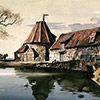The oil is one of the best techniques for painting. It is a mixture of resins and oils with pigments. Oils give fluidity and pigments can be thicker and harder. Oil paintings add much capacity for representation because they allow us to create many shades and color quality is very high. They allow us to work slowly because it dries slowly. This allows gradients, fades and shadows, while we observe reality. But most of his success is that once dry, the paint still has vivid color and powerful, thanks to its oily base.
Advantages of oil painting:
- Excellent color. Depending on the brand we can find colors created with high quality pigments. For example MAIMERI PURE oils, with special pigments.
- Control of the thickness of the paint. We can do fillings and glazes. Oil paintings can be dissolved with inseed oil, turpentine and other mediums for oil. And it can be thickened using pigments and paste oil mediums, a special paste made to mix with oils.
- Material persistent in time and good quality of the colours. The oil painting has existed since the late fourteenth century, and the artworks continue with a color still fresh and alive, after some cleaning and restoration processes.
Disadvantages:
- The classic oil is handled Turpentine (white spirit), which is toxic and it stinks. It is therefore necessary a site with ventilation. Today there are new oils that do not smell and can be diluted too much with other media without odor or toxicity.
- The time required to dry the oil can try to reduce or extend to other liquid chemicals designed for this. But never will be immediate drying.
Quick start painting. Ready to paint:
1. Having a site that you can prepare and to leave ready with the following materials:
– A stand for canvas or wood.
– A box of oil paints, a palette and mix colors support (I use a plate, tile, glass) and medium (liquid to dissolve).
– Lots of good brushes of all sizes and shapes.
– The site should provide air and light.
2. Having a clear idea of what you want to paint.
3. Have at least two hours because otherwise it would not be worth it.
Calculate the time needed to focus and prepare to paint. And also the time that is used to clean and pick up a little at the end. This time is subtracted from the time you have to paint the work.
4. No visits or interruption of any kind.
The phone turned off. Beware of the sounds that surround and influence us.
5. Calculate the degree of comfort and if something bothers detect and fix it.
It´s very important that things are organized and easy to access when they are needed.
Techniques of oil painting.
1.Influence of imprimation and support.
– Paint over white imprimation. If you want to go from the light coloring. Widely used in marine and landscapes.
– Paint on color imprimation. Thinking that color affect our view of the work. For example, this technique is used to make portraits that emerge from the darkness (as in the Baroque). And other modern styles where we can let the color behind mix with the painting.
– Also influences the support chosen work: paper, cardboard, wood, tablex, canvas, types of cloth, and others who may choose.
2. Impasto expressive capacity.
The impasto can be used in many forms: painting with a palette knife or brush pointillism, brushwork, textures applied with colored paste, oil paste and collage, among other things that the imagination can design.
So it does if we apply in the imprimation any specific texture. We can choose from marble dust, pumice, sand or the othesr we like. Never with organic materials.
3. Glazing, transparencies and tonal work.
The glazing works better or worse depending on the colors that we mix and in what order. This is because there are some colors that are transparent and some that are opaque.
Transparencies or glazing can be created as optical effects and visual tricks that the oil paint does. Especially with the mineral spirits control work, the tone and color.
4. Fusion of Colors.
It´s carried out thanks to the humidity of the paint during the drying time. Therefore, it is a job especially with wet paint solvents and to lengthen the drying time. To create gradients we can paint wet on wet painting and dry brush technique.



